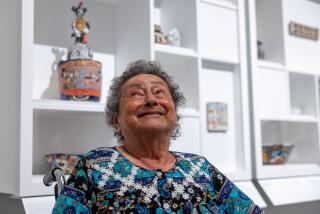John Waters, Jeff Koons to compare notes
What can we expect when the “Pope of Trash” meets the “King of Kitsch”?
John Waters, iconoclastic filmmaker, actor, artist and, yes, Pope of Trash, takes the stage at downtown Los Angeles’ Orpheum Theater on Monday night to interview contemporary artist Jeff Koons.
“The Un-Private Collection,” the art-focused lecture series organized by the Broad museum under construction in downtown Los Angeles, on Monday will stage its largest event to date: a conversation between Waters and Koons, who will discuss his work in the Broad collection. Nearly 2,000 people are expected to attend.
PHOTOS: Arts and culture in pictures by The Times
“We’ll talk about everything,” Waters says by phone from his home office in Baltimore. “Jeff’s artwork, everything from childhood to sex, everything that art’s about.”
It’s an intriguing if odd pairing, but it’s also one that makes sense. Both Koons and Waters are artistically large, irreverent and iconic figures who touch on consumerism, nostalgia and American domesticity in their work. Both humorously employ screaming colors and often kitschy, over-the-top imagery to play with social and pop-cultural tropes. Waters’ film titles — “Pink Flamingos,” “Polyester,” “Hairspray” — even sound like the names of Koons artworks, which, in the Broad collection, include an inflatable pink bunny installation and a gleaming, aqua “Metallic Venus” sculpture.
“They both, in very different ways, play with ideas about good versus bad taste,” says Joanne Heyler, chief curator and director of the Broad. “Their common roots may be a topic; John lives in Baltimore, Jeff went to school there.”
One thing Waters won’t talk about — on the phone, anyway — is his own work of late, which includes a forthcoming hitchhiking memoir, “Carsick,” due out in June and an art exhibition of photographs and sculptures, “Bad Director’s Chair,” that recently opened at Sprüth Magers gallery in Berlin. He also continues to perform his long-running one-man show, “This Filthy World,” internationally.
PHOTOS: Behind the scenes of movies and TV
“No more about me. This is an interview about Jeff,” he insists on the phone. “He’s incredibly serious and at the same time misleading but also impenetrable. Which means sometimes you look at his work and you’re struck dumb by it — and I like that. It’s often cheery and upbeat, but it’s also scary.”
Koons notes an obvious point of intersection between Waters and him.
“I find in my work acceptance plays a big role,” he says. “When I think of John’s films, they’re often about being open to the world and not having judgment. I’m a big fan.”
Eli and Edythe Broad have one of the largest collections of Koons’ work worldwide — 33 pieces, with three more acquisitions in progress. The collection includes Koons’ famous “Balloon Dog (Blue), 1994-2000,” the stainless-steel “Rabbit, 1986,” and “Michael Jackson and Bubbles, 1988” as well as two pieces from the artist’s most recent body of work, the Gazing Ball series.
Broad says he first laid eyes on Koons’ work in 1982, and he and his wife were taken with it immediately.
“Edye and I visited his studio several times, and it became clear to us that his work was an important reflection of what is happening in our society and the world,” Broad says. “After Duchamp and Warhol, Jeff Koons is the most important artist of his generation.”
CRITICS’ PICKS: What to watch, where to go, what to eat
This summer, Koons will have a career retrospective at the Whitney Museum of American Art in New York. It will be the last exhibition at the Whitney’s Madison Avenue location before the museum moves to a new, Renzo Piano-designed building in the High Line area of Manhattan. Koons says that planning for the Whitney show, which will feature more than 100 pieces and will fill the entire museum except for the top-floor galleries, is “going great,” but he seems most excited about the in-progress Broad museum, and its place in his legacy.
“I really foresee the Broad as being what Philadelphia was for Duchamp,” Koons says. “They have the largest and most significant [Duchamp] collection in the world. People make pilgrimages there to see and understand his work — and it seems to me, from the collection they have, that’s what the Broad may be for my work in the future.”
In late May, the “Un-Private Collection” will stage a talk between Takashi Murakami and Pico Iyer about, among other things, ancient and modern culture in Japan; in June Steve Martin and the artist Eric Fischl will likely discuss their friendship, comedy and the American psyche, Broad curator-director Heyler says; in October artist Kara Walker will speak with filmmaker Ava DuVernay about how issues relevant to African American women manifest in their work; in September the artist John Currin will speak with the Getty Trust’s Jim Cuno about the relationship between his work and classical painting as well as his works in the Broad collection.
Monday’s event, co-presented with the Library Foundation of Los Angeles’ ALOUD series, promises to be “completely raucous, lively and fun,” says the Broad’s director of audience engagement, Ed Patuto. “I’m sure Lady Gaga will come up — another person who really pushes things to the extreme. Jeff designed her last album cover. People should expect to laugh a lot. It’s not gonna be your typical art talk by any stretch of the imagination.”
----------------------------------
The Un-Private Collection: John Waters and Jeff Koons
Where: The Orpheum Theatre, downtown L.A.
When: 7:30 p.m. Monday
Tickets: Sold out. Stand-by tickets available. Will call opens 5 p.m.
Information: https://www.thebroad.org/programs
More to Read
The biggest entertainment stories
Get our big stories about Hollywood, film, television, music, arts, culture and more right in your inbox as soon as they publish.
You may occasionally receive promotional content from the Los Angeles Times.











